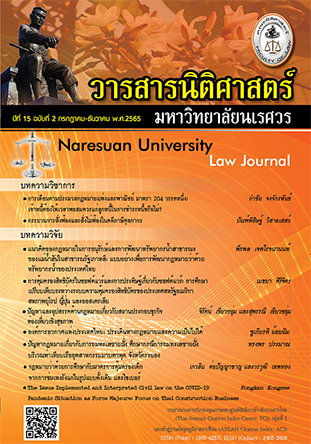The Issue Implemented and Interpreted Civil law on the COVID-19 Pandemic Situation as Force Majeure: Focus on Thai Construction Business
Main Article Content
Abstract
One of the most significant threats that might have an effect on the obligations of the parties to a contract in the construction industry is force majeure. The concept of “force majeure” is fundamentally a civil law phrase, and it may be found in the civil codes of most civil law regimes. However, common law does not recognize it with the same wide meaning and application as civil law does. The law prohibits one or both parties from fulfilling their obligations for reasons that are beyond their control and expectation, the occurrence of a force majeure event has the potential to have a major influence on the performance of the contract. According to the COVID-19 outbreak, COVID-19 scenario and the government anti-pandemic measures deemed or interpreted as force majeure in Thailand construction contract. Thus, it is essential for construction contracts to provide a force majeure clause that has been carefully drafted. This will enable the aggrieved party to delay further execution of the contract’s obligations until the triggering event has passed or, in some instances, to terminate the contract altogether. This paper aims to provide a comparative law analysis of force majeure under the civil law and common law framework of the UK, the US, and Thailand in order to understand the legal implementations in Thailand. Then the duties of the parties to the contract will continue to be a cause of dispute in the future. Therefore, in order to reduce disputes
that usually arise in terms of building contracts, analysis of force majeure in construction contracts in Thailand and other countries will be required.
Article Details
References
Bunni, Nael G. The FIDIC Forms of Contract. London: John Wiley & Sonsm, 2013.
Federation Internationale Des Ingenieurs-Conseils. Conditions of Contract for Works of Civil Engineering Construction. 4th ed. Geneva: Federation Internationale Des Ingenieurs-Conseils, 1987.
Fumagalli, Elena, Luca Lo Schiavo, SL Salvati, and Piercesare Secchi. “Statistical Identification of Major Event Days: An Application to Continuity of
SupplyRegulation in Italy.” IEEE Transactions on Power Delivery 21, no. 2 (2006): 761-767.
Garner, Bryan A. Black’s Law Dictionary. 8th ed. St. Paul, MN: Thomson West, 2004.
Hagedoorn, John, and Geerte Hesen. “Contract Law and the Governance of Inter-Firm Technology Partnerships: An Analysis of Different Modes of Partnering and their Contractual Implications.” Journal of Management Studies 44, no. 3 (2007): 342-366.
Haley, Geoff. “Model Contracts in the Construction Industry.” Amicus Curiae 17 (1999): 8-14.
Hariri, Mehdi. “Force Majeure: A Comparative Approach to Different Legal Systems.” World Applied Programming 3 no. 6 (2013): 247-251.
Johnson, Natasha. “COVID-19: Pressure Point: Will this be valid Basis for Avoiding Contractual Obligation (UK).” Accessed February 8, 2022. https://www.herbertsmithfreehills.com/latestthinking/i s-covid-19-likely-to-be-a-valid-basisfor-avoiding- contractual-obligations.
Kessedjian, Catherine. “Competing Approaches to Force Majeure and Hardship.” International Review of Law and Economics 25, no. 3 (2005): 415-433.
Klass, Gregory. “Interpretation and Construction in Contract Law.” Accessed January 19, 2022. https://ssrn.com/abstract=2913228.
Koksal, Tunay. “Fidic Conditions of Contract as a Model for an International Construction Contract.” Business and Management Review 1, no.2 (2011): 32-55.
Malanczuk, Peter. Akehurst’s Modern Introduction to International Law. 7th rev. ed. London: Routledge, 1997.
McLauchlan, David. “Frustration in the Court of Appeal.” Victoria University of Wellington Law Review 44, no.3/4(2013): 593-608.
Ndekugri, Issaka, Nigel Smith, and Will Hughes. “The Engineer under FIDIC’s Conditions of Contract for Construction.” Management and Economics 25, no.7 (2007): 791-799.
Patterson, Edwin W. “The Interpretation and Construction of Contracts.” Columbia Law Review 64, no. 5 (1964): 833-865.
Polkinghorne, Michael, and Charles Rosenberg, “Expecting the Unexpected: The Force Majeure Clause.” Business Law International 16, no. 1 (2015): 49-64.
Poonja, Mahmood M. “Termination of Treaties Owing to Fundamental Change of Circumstances (Clausula Rebus Sic Stantibus).” Ph.D. diss. Charles University, Praguem, 1977.
Rodger, Chris, and Jason Petch. Uncertainty & Risk Analysis: A Practical Guide from Business Dynamics. United Kingdom: Business Dynamics, Price Waterhouse Coopers, 1999.
Ryan, Janice M. (2011). Understanding Force Majeure Clauses. Accessed. https://www.herbertsmithfreehills.com/latestthinking/i s-covid-19-likely-to-be-a-valid-basisfor-avoiding-contractual-obligations.
Ryan, Janice M. “Understanding Force Majeure Clauses.” Accessed February 8, 2017. https://www.venable.com/insights/publications/2011/02/understanding-force-majeure-clauses.
Seppala, Christopher R. “Contractor’s Claims under the FIDIC Civil Engineering Contract, Fourth (1987) Edition.” Int’l Bus. LJ 9, no. 9 (1991): 457-460.
Wallace, Duncan. Constructions: Principles and Policies in Tort and Contract, Vol 2. London: Sweet & Maxwell.
Wehberg, Hans. “Pacta Sunt Servanda.” The American Journal of International Law 53, no. 4 (1959): 775-786.
Wright, William Cary. “Force Majeure Delays.” The Construction Lawyer 26, no. 33 (2006): 33.


